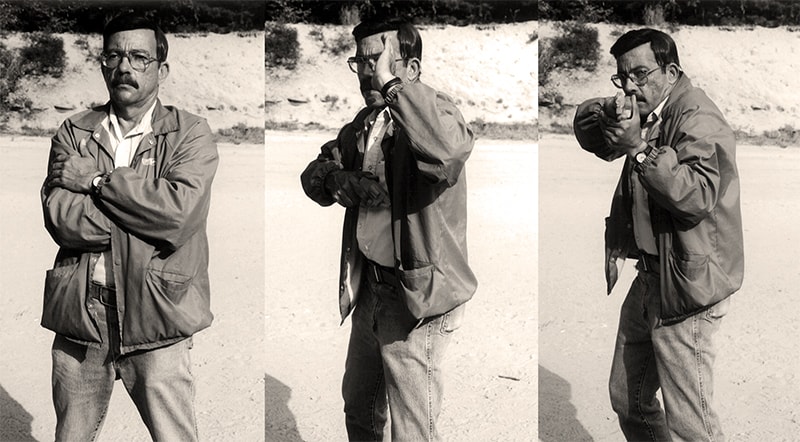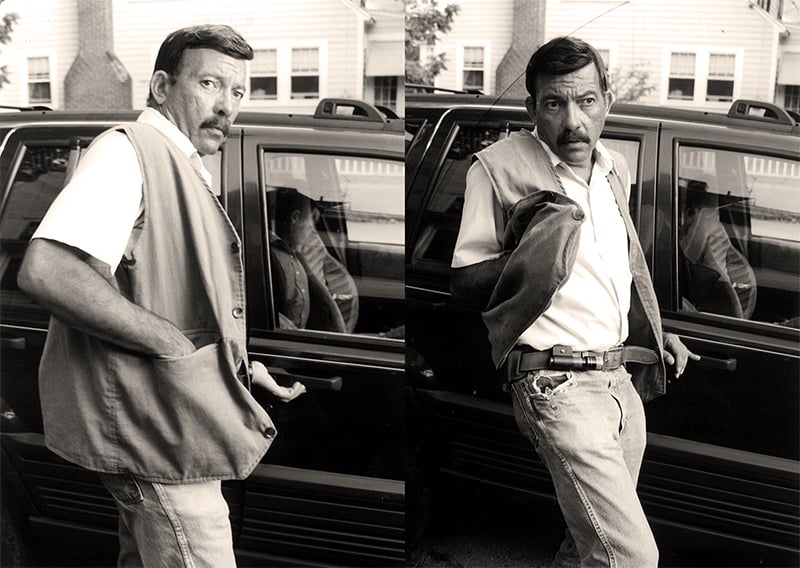Stealth Draw
Here are some street-proven tricks
The ability to use stealth and intelligence to gain the upper hand on an opponent, and hopefully control an impending fight before anyone gets hurt, is the essence of street smarts. It’s what I call “weaselcraft” and one of the most important tactics involves a surreptitious draw. I want my gun in my hand when a dangerous situation presents itself, but not at the expense of betraying to my opponent that I am armed. I want the element of surprise. Let’s look at some examples, all of them proven in the real world.
Sneaking The Hand To The Gun
I hate that word “sneak” because it has connotations that rightfully belong more to the bad guy than the good guy. But, sometimes, making ready in “stealth mode” is the best thing to do. An overt movement can “frighten the horses,” give people the wrong idea about who is a danger to whom, and can even turn a situation that was escapable without bloodshed into lethal violence. Let’s look at one example.
The officer is one of three responding to a report of a crowd of threatening thugs. They want this resolved without bloodshed, but some of these punks are known to be armed. It’s a cold, windy autumn day, and the officer in question has his long coat on. The side pockets are cut away to reach his holstered handgun.
As the approach begins, he surreptitiously shoves his hands into what looks like his pockets, but his right hand is firmly around the stocks of his Colt service revolver. Contact is made.
In an instant, the balloon goes up. Guns come out. This officer’s weapon comes swiftly into play, jack-knifing the most dangerous of the opponents, a man reputed to be a stone-killer who is in the act of reaching for an assault rifle. That done, the officer turns to his left and nails a man who’s firing a Smith & Wesson revolver at a brother officer. In moments, it is over: three offenders dead, two officers wounded, the officer in question unscathed.
The story is true. The officer was Wyatt Earp, and the incident was the one that took place near the OK Corral in Tombstone, Ariz. There have been countless variations of this epic gunfight published by historians, but most agree that Earp had his hand on the butt of his .45 caliber Single Action Army when the fight began, and reached through his pocket before the shooting started to acquire that drawing grasp. His first bullet folded Frank McLaury before he could unlimber the Winchester lever action rifle he was trying to bring into action against the Earp party, and then Earp shot Billy Clanton.
For many years, NYPD “reefer coats,” the long winter uniform overcoats, were made with gun-slits in the pockets so officers could access their holstered .38 Specials in just the same way. I have a modern police uniform foul-weather coat that is so equipped.
What about the private citizen, or for that matter the plainclothes officer? There are several ways the hand can be on the holstered gun beforehand without flagging to everyone watching that you are holding a firearm. With a shoulder holster, a simple folding of the arms allows the gun arm to be inside the jacket, hand on pistol, covered from all but the most discerning eye by the overlapping free arm. Something similar can be done with a cross-draw holster.
Most of us carry behind the strong side hip. That’s harder to reach without people noticing. If there is no one behind you who is dangerous or likely to misunderstand what you’re doing, you can turn your strong side hip back away from the threat. Now, bring both arms in as if you were putting your hands on your hips. Some see this as a body language gesture of hostility, while others read it merely as expressing exasperation. If your gun hand comes up under the bottom edge of the concealing garment, however, it can take a drawing grasp on the holstered sidearm.
Why is this so important? It roughly cuts in half the time it takes to respond, draw and fire. Most of us take about 1.5 seconds to draw, fire and hit at seven yards with our hands clear of the holstered weapon. Add at least a half a second to that if you are wearing your gun concealed, as you probably will be in real life. However, with the hand already on the holstered gun and gripping it firmly, the part of the draw that requires fine motor skills is done and only the part that needs simple gross motor skills remains. You should be able to rip the gun up, bring it on target and break the shot in under a second.
The Ankle Draw
When accessed from a standing position, the ankle holster is hampered by a notoriously slow draw. However, when the user is seated or knocked to the ground, the placement of a gun now comes into its own.
The Southern police officer has read my article on backup guns, and one part in particular has hit home. I had mentioned that when seated behind a steering wheel and seat-belted in place, the ankle gun is often easier to reach than the hip holster. He has noted that he can’t draw his duty gun from its SS-III security holster while seated and belted behind the wheel of the patrol car.
He buys a Colt Agent .38 snub and a good ankle rig, and gets into the habit of letting his hand drift to it when someone he doesn’t trust approaches his parked police car.
He does that on the night in question, because the man wearing a long coat in hot weather looks agitated as he comes up to the cruiser. Suddenly, a sawed-off shotgun flashes from under the coat, and blooms roaring flame.
The cop jerks his head away in time to save his life and eyesight, though he will be disfigured for life from his wounds. His hand is already holding the ankle holstered Colt, and before the gunman can cycle another shell into the chamber, the cop empties the .38 into him. The cop will survive and return to full duty. The offender, horribly crippled, will get a long sentence for the attempted murder of a police officer.
Make sure your pant legs are loose enough to allow you access to the ankle rig. A good thing about this holster is that if you’re flexible enough, you can reach it with either hand if you have been disarmed of your primary weapon or manacled.
I don’t like safety straps on ankle holsters. Most so fitted rely solely on the strap to hold the gun in place, and can be accidentally released by running through brush or crossing your ankles. I want a gun that is held friction-tight. This also allows a silent, surreptitious draw.
When the bad guy has his back turned and I’m stealthily reaching for my gun from an awkward position where I can barely reach it, this is really a lousy time for him to hear the snap of my safety strap releasing, or the rip of a strip of Velcro being cleared.
When you have to fire from awkward positions and can’t bring the sights to the eyes, a laser unit comes into its own. This is one reason I like the Crimson Trace LaserGrips for my backup J-frame snubby.
Belly Draw
A small handgun in a belly band holster lends itself beautifully to a surreptitious draw. The 4” elastic strap with “holster pocket” is best placed right at belt level, with the gun butt forward just to the weak-hand side of centerline. Now you can drop your hands as if grasping your stomach, a common body language gesture of helpless surrender and weakness that is enhanced if you can drop your shoulders and try to make your face look shocked.
The hand is inside the shirt, already on the gun, all concealed by your forearms. You’re ready to make a fast and deadly draw if you have to, and you look like a crumpling victim.
Pocket Draw
For years, big-city investigators made a habit of putting their .38 snubbies in their overcoat pockets, in hand and in firing position, when they accosted suspicious persons. Generations of uniformed cops did the same thing with backup guns when weather allowed them to wear bulky uniform coats. In summer, a hand on a belly gun in a side trouser pocket came close to offering the same speed.
A New York cop is savvy about backup guns, and feels the pocket is the most sensible location for him. He goes from 4″ on-duty and 2″ off-duty, to both guns all the time. One winter night, his 4″ S&W is buttoned under two coats and his 2″ Colt in the coat pocket when he takes a subway ride. He’s about to reach his stop when two muggers approach him, one with a knife, the other holding a .25 auto to his head.
Feigning compliance as if reaching for his wallet, the cop snakes his hand into the coat pocket and takes a good grip on the .38 Detective Special. Then, in one smooth movement, he bats the suspect’s .25 aside with his left hand, draws with the right, and shoots his antagonist in the head with the little Colt. The man collapses, killed instantly, just as the train pulls into its stop. His accomplice flees, to be captured, convicted and sentenced later. The officer is unharmed.
In a trouser pocket in particular, you want a good pocket holster. This will break up the outline of the gun, prevent sharp front sights from wearing through the trouser fabric, and orient the gun in the same place all the time. It will usually speed the draw.
There are several good pocket holsters on the market from the likes of Sparks, Alessi, Kramer and Rosen.
In a coat pocket, you have the option of firing right through the fabric at very close range. You’ll want a shrouded hammer revolver like the S&W Bodyguard or Centennial for this. A conventional revolver’s hammer spur or exposed firing pin can snag fabric and jam the gun, and an auto pistol doesn’t guarantee more than one shot when fired from inside surrounding fabric.
Concealed Carry Clothiers makes a very nice concealment vest with a built-in pocket for a J-frame S&W or equivalent revolver.
The Bag Trick
A gun hidden inside a paper bag has been the staple defensive tactic of many a high-robbery-risk storekeeper when he went to the bank to make his deposits. When the bag is held close to the body, particularly in a public place where there are stores and people are all over the place carrying bags with their purchases, no one looks twice.
The Asian couple had immigrated to America and settled in California. They worked hard and prospered. They learned quickly that there was violence here. The husband bought a short-barrel .357 Magnum revolver to protect his store.
The night came when he was in the back room and heard suspicious sounds out front. He took his gun and put it in a paper bag, and sauntered casually out. There he saw to his horror the armed robbers who were terrorizing his wife. They turned toward him, and dropped their guard when they saw he was holding only a paper bag.
It was their last mistake. Sheets of orange flame exploded from the bag. One robber died before he could pull his trigger. The other got off a shot that slightly wounded the storekeeper, and then a bullet from the magnum tore his life away before he could fire again. It ended with both gunmen dead, and the husband and wife safely and completely recovering from minor injuries. The double homicide was ruled justifiable by the authorities.
The most effective way to use the “paper bag trick” is to take a new one that is still crisp with some body to it, and make a roughly half-length slit low in one side. The hand holding the revolver goes through the slit. (The close confines of the bag could compromise the operation of an auto pistol, especially if anything else is in the bag with it.)
If you need “urban camo,” a newspaper inserted upright into the bag will do nicely. Unless it’s the Sunday New York Times and you’re shooting a mouse gun or pre-fragmented projectiles, you shouldn’t deflect your outgoing bullets.
The support hand should be under the bag as if holding it with something heavy inside. If you need to fire, make sure the support hand contacts the firing hand, if only to keep it out of the path of your own bullets! This is one time you can make use of the otherwise obsolete “cup and saucer” hold, as illustrated in the photos.
You’ll also have to “point-shoot” from here, since the bag blocks the sights and raising the arms to eye level will lift the bag high enough to block the target from your view.
Coat Over Arm
If you have a coat you’ll look natural enough with it draped over your arm. A handgun held in your fist, with your fingers wrapped around frame and cylinder or frame and slide, will now be no longer than an arm with extended fingers, and the draping coat hides it all. No, the gun isn’t in firing position, but it is drawn and readily accessible. A snub .38 could be held in firing position here, but the muzzle will be pointing at everyone around you and responsible people don’t do that with a gun in firing position.
Bad guys do this all the time with sawed-off shotguns. Good guy executive protection specialists are known to do it with folded-stock submachineguns. The gun is held by the fore-end in the weak hand when done by the good guys. A flip of the arm clears the coat, and the free dominant hand can go to a firing position. This is not something I’d recommend for the average person, but it’s good to be aware of when scouting out potential dangerous felons.
I hope you’ll never need the stealth draw, but if you ever do need it, I hope you can bring it off. Use common sense, and train for anything you think you’ll ever have to do.

Sign up for the Personal Defense newsletter here:









